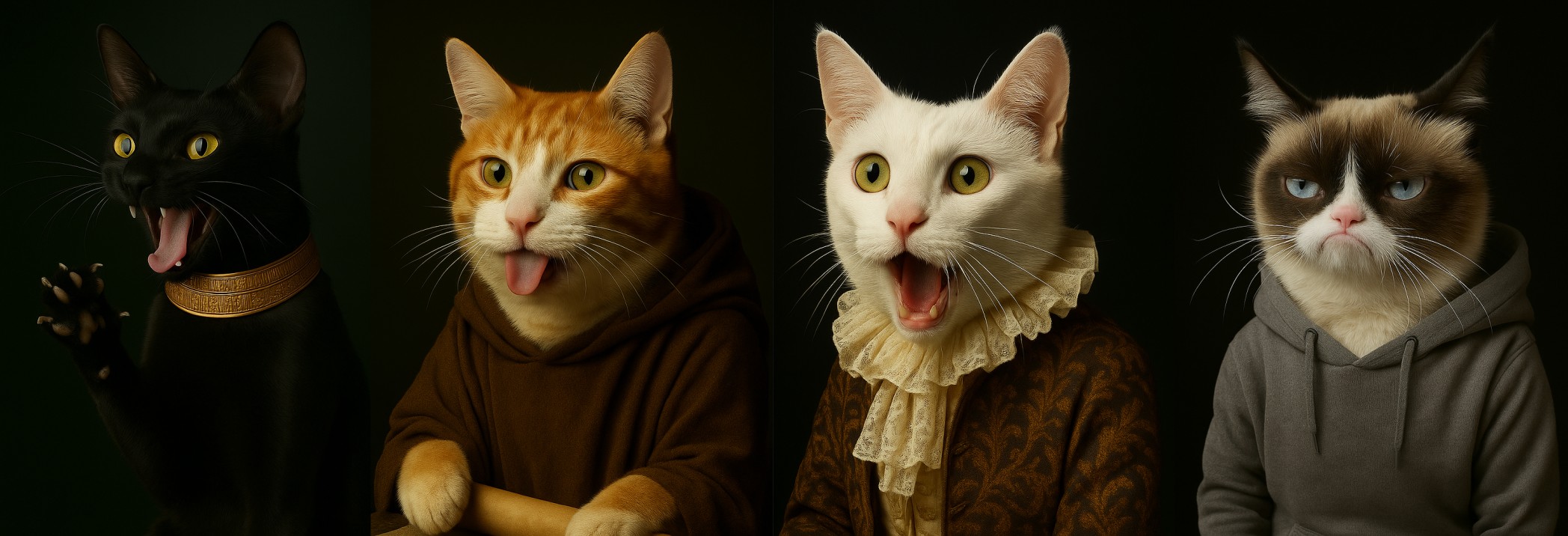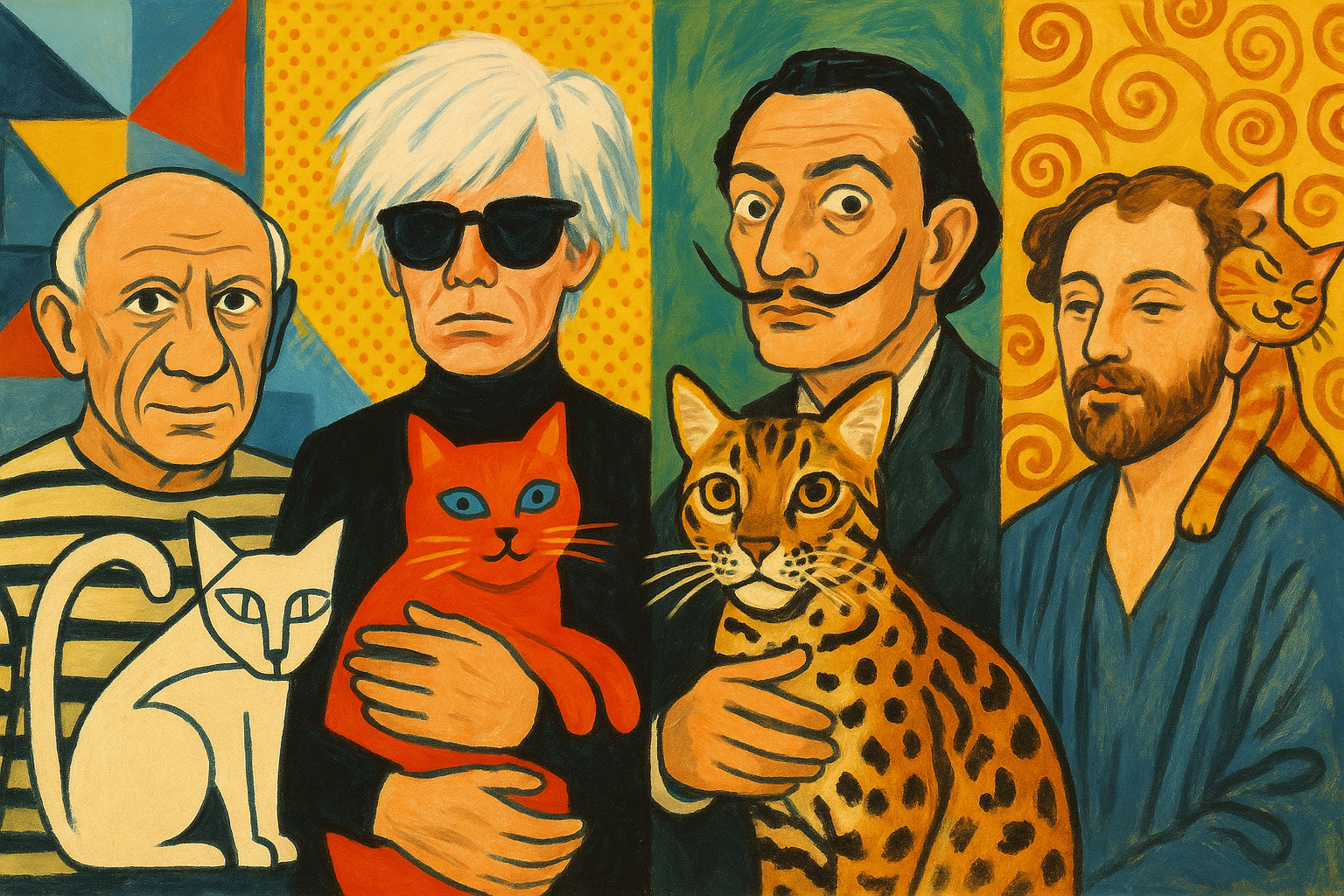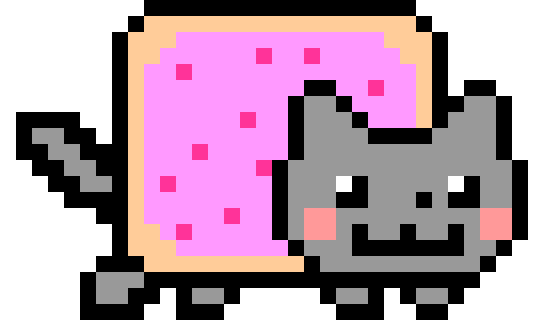“The smallest feline is a masterpiece.” Leonardo da Vinci
Claw-ver Muses
How cats went from temple gods to meme royalty without lifting a paw
They say never work with children or animals. Artists never listened. For centuries, cats have padded across canvases, clawed at manuscripts, and hijacked sculptures. Regal yet ridiculous, aloof yet affectionate they’re contradictions in fur. Which makes them the perfect muse.
Still not convinced? Check out the Smithsonian’s “Before Internet Cats” exhibition for proof that we’ve admired feline art long before LOLcats . Or browse “Cats in Art: From Renaissance Paintings to Digital Memes” to see how they moved from tombs to TikTok . Feeling nostalgic? Let the Met’s “Meow Met” Chrome extension surprise you with quantum-cat art every time you open a new tab

Cats, Always the Headliners
Peak Purrfection
Ancient Egypt? Peak fandom. Bastet, the Egyptian cat goddess filled with feline statues, cat cemeteries stacked with mummified kitties, and laws so strict that harming one could get you killed. Basically, Egyptians treated cats like Beyoncé sometimes backstage, but always the star. Thousands of years later, we’re still building shrines to them. We just call them cat cafés now.
By the Middle Ages, the vibe had shifted. Cats weren’t just companions they were mystical, suspicious, sometimes feared. Witches supposedly whispered to them as familiars. People swore they had nine lives and could slip between worlds. Which, honestly, feels accurate when you watch a cat fall off a shelf, twist midair, and land like nothing happened.
And when they weren’t performing sorcery? They were strolling across freshly inked manuscripts. One surviving copy in the Dubrovnik still shows a manuscript marked with cat pawprints a cat left in the 1400s. If you’ve ever had your cat walk across your laptop during a Zoom call, congratulations you’ve recreated medieval monastic life.
The Renaissance brought things back to admiration. Da Vinci sketched cats like a man in love. Dutch painters used them as metaphors for temptation, while Rococo artists softened them into aristocratic props. Cats weren’t background noise they were the plot twist, the post-credit reveal.
And then came the Victorians, who turned cats into a whole subculture. London was crawling with them, kept alive by “cats’-meat men” delivering boiled horseflesh door to door. Then Louis Wain arrived, turning scrappy mousers into tea-drinking, card-playing, business-running citizens. H. G. Wells said it best:
“He invented a cat style, a cat society, a whole cat world.” H.G
Nine Lives, 70 Breeds, Infinite Myths
Marginal Mischief
Here’s the wild part: today, there are around 70 recognized cat breeds from the hairless Sphynx to the cloudlike Ragdoll. And yet the scrappy alley cat, the no-name mix still rules memes, paintings, and TikToks.
Because cats don’t need pedigree. They have mythology. “Cats out of the bag” came from medieval markets. Black cats became Halloween icons. Nine lives turned into shorthand for resilience. Cats live in our stories as much as in our homes.
As Dan Alexander might point out: in a world obsessed with categories and labels, cats slip through the cracks, smirking. They remind us that the box is always Schrödinger’s until they decide to sit in it.
Modernism
Cats Get Weird
The 20th century wasn’t subtle. Picasso painted them as violent predators. Franz Marc turned them into symbols coded by color blue for masculinity, yellow for joy. Chagall floated them through dreamscapes like surrealist angels.
Andy Warhol turned his 25 cats named Sam into pop icons, each a mashup of elegance and absurdity. Salvador Dalí staged mid-air cat photography (ethics questionable, visuals legendary). Georgia O’Keeffe let her cats roam her desert studio like furry art directors.
Meanwhile, T.S. Eliot’s Old Possum’s Book of Practical Cats built the foundation for Cats: The Musical proving no art form, not even Andrew Lloyd Webber’s glittery fever dream, can resist a feline.

21st Century
Purr-sonal Branding

Ai Weiwei’s cats photobomb his Instagram like they’re on retainer sprawled on sculptures, inspecting works-in-progress, or claiming prime spots in the studio. They’re not decoration; they’re artistic directors in fur coats.
Online, @nala_cat and @hosico_cat rake in millions of followers, merch deals, and headlines, while Grumpy Cat and Lil Bub became global icons.
Cats dominate GIF libraries, headline meme history, and even sneak into NFT marketplaces.
In a world obsessed with algorithmic trends, cats are immune.
They don’t plan their feed they are the feed. Much like Sillygoose.co or Matt Mccarthy turns everyday art into something collectible, cats turn everyday moments into cultural gold.
The Ultimate Cat World Tour
From temples to tea houses to TikTok-famous tabbies, here’s your passport to feline culture.
Museums & Temples
- KattenKabinet — Amsterdam, Netherlands: “An art museum devoted entirely to feline depictions, from Picasso sketches to
- Toulouse-Lautrec posters. Think: Louvre, but every subject is a cat.”
- Kuching Cat Museum — Kuching, Malaysia: “Over 4,000 cat artifacts, from ancient statues to pop culture tributes, plus a taxidermied wild Bay cat for the truly curious.”
- Moscow Cat Museum — Moscow, Russia: “Since 1993, this quirky space has celebrated cats in art, toys, and literature. Don’t miss the ‘Cat’s Eye’ exhibit.”
- Istanbul Cat Museum — Istanbul, Turkey: “Part gallery, part street culture archive, weaving Istanbul’s feline history into paintings, photography, and folk stories.”
- Gotokuji Temple — Tokyo, Japan: “Spiritual home of the maneki-neko (beckoning cat), with thousands of porcelain figures creating a hypnotic photo backdrop.”
Cat Cafés That Feel Like Theme Parks
- Lady Dinah’s Cat Emporium — London, UK: “A two-story Alice in Wonderland–themed escape serving high tea alongside lounging rescue cats.”
- Temari no Ouchi — Tokyo, Japan: “A fantasy village–style cat café with interiors that look like a Studio Ghibli set, complete with hidden alcoves for feline hide-and-seek.”
- Cat Town Café — Oakland, USA: “America’s first permanent cat café, offering coffee, pastries, and adoptable rescue cats in a bright, modern space.”
- The Cat Café — Singapore: “Minimalist and airy, with specialty coffee, themed desserts, and a focus on rescue cat welfare.”
Festivals & Parades
- CatCon — Los Angeles, USA: “Imagine Comic-Con for cat people: panels, art markets, adoptable kittens, and TikTok-famous tabbies strutting the floor like they own it.”
- Kattenstoet — Ypres, Belgium: “Medieval tradition meets parade floats the size of buses but shaped like cats. Think brass bands, elaborate costumes, and cat-shaped chocolates.”
- Neko Matsuri — Japan: “Entire neighborhoods transform into cat shrines, with fish-shaped pastries, paw-print bunting, and more feline masks than a Venice carnival.”
Final Thought
Adopt a Muse
So why do cats keep showing up on temple walls, in manuscripts, in memes?
Because they refuse to be predictable. They’re soft and sharp, affectionate and aloof, cuddly and chaotic. They’re metaphors waiting to happen.
Artists don’t chase cats because they sit still. They chase them because they don’t. Cats are the embodiment of creativity itself: elusive, contradictory, full of sudden leaps that somehow land on their feet.
Maybe that’s the lesson. Art isn’t about control. It’s about curiosity. And cats are nothing if not curious.
From sacred statues to viral GIFs, cats have always been more than animals. They’re muses, mirrors, myths, and memes all rolled into one. But the most inspiring cat won’t be in a gallery or on a feed. They’re probably waiting at your local shelter ready to sprawl across your keyboard, curl up in the sun, and change your life in ways no algorithm can explain.
Adopt your muse. Every artist needs one.
References
- Andrew Lloyd Webber: Cats: The Musical
- Andy Warhol (1954): 25 Cats Name Sam and One Blue Pussy
- Cat Fanciers’ Association: Recognized Cat Breeds
- Croatian State Archives (15th century): Manuscript with Cat Pawprints, Dubrovnik
- Desmond Morris (2017): Cats in Art
- Georgia O’Keeffe: Biography
- Leonardo da Vinci (1505): Codex on the Flight of Birds
- Royal Collection Trust: Cats, Lions and a Dragon
- Smithsonian Institution (2017): Before Internet Cats
- T. S. Eliot (1939): Old Possum’s Book of Practical Cats
- The British Museum (2014): Bastet: Guardian of Ancient Egypt
- The Metropolitan Museum of Art (2015): Meow Met Chrome Extension



